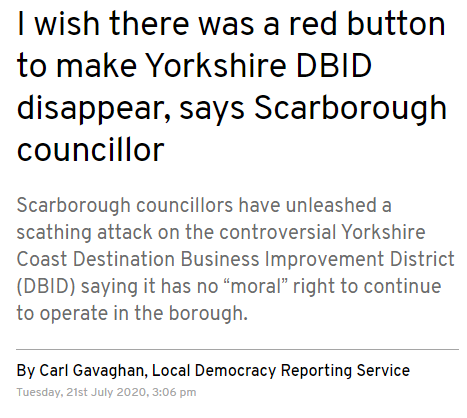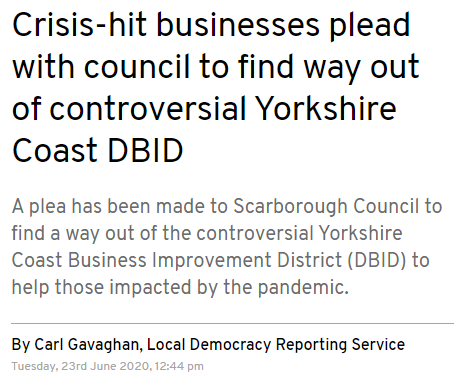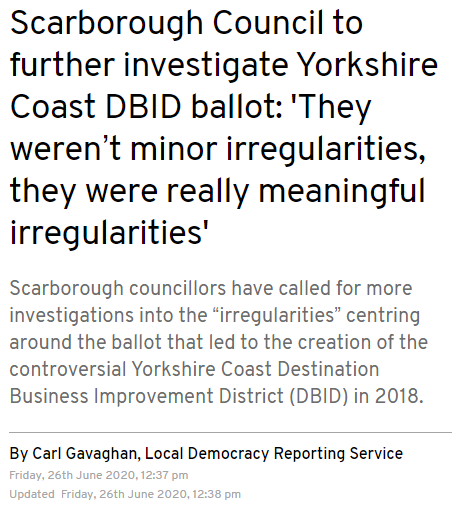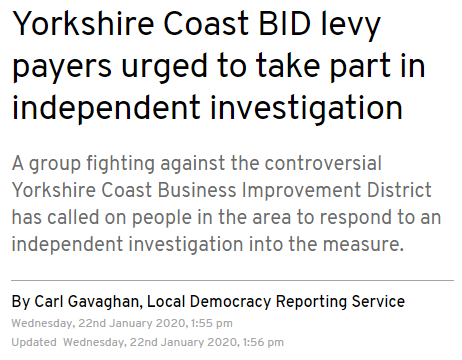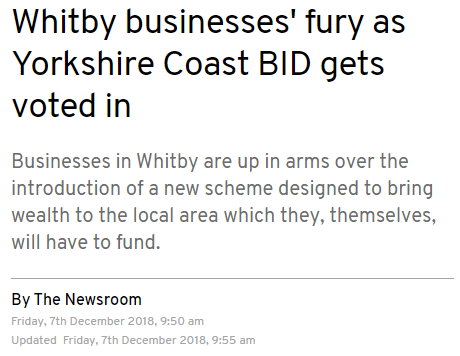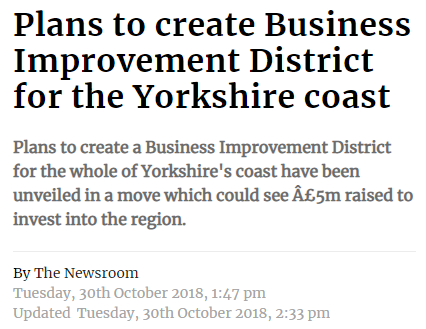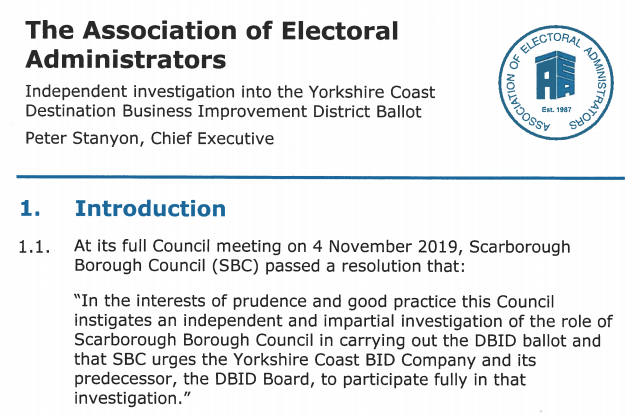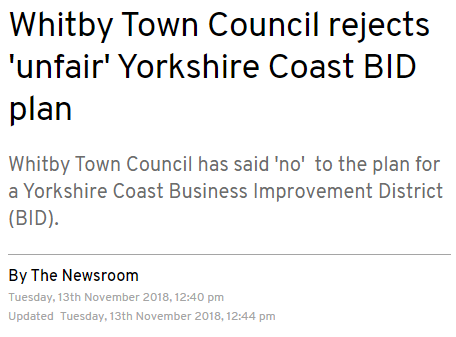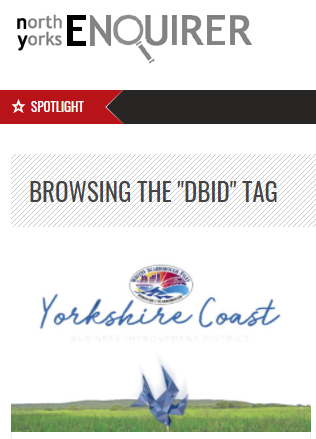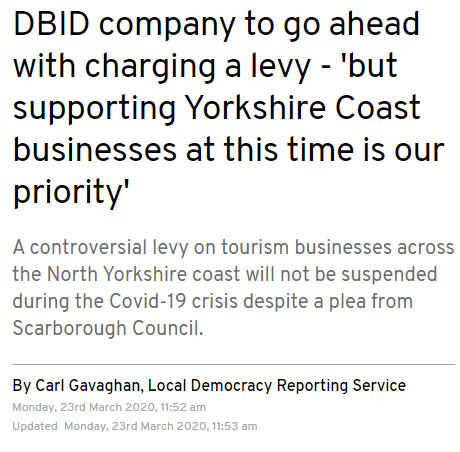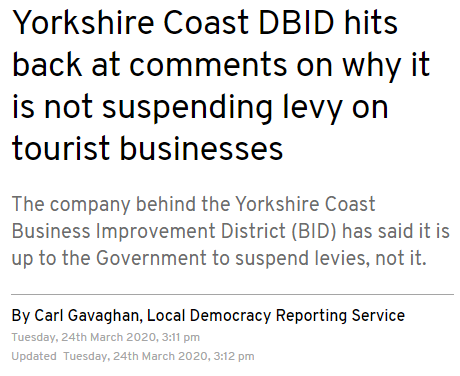Let’s start with some press headlines, sets the scene well about what’s going on with the Yorkshire Coast DBID.
So why all the fuss?
Through a failed BID development process the BID was ‘voted’ for in late 2018, but without the support of the true majority of businesses, in addition to a questionable ballot process for which the advising BID Consultant was none other than Mo Aswat of The Mosaic Partnership.
Just look at the ballot numbers and it tells a story straight away:
1354 businesses on the Council ballot list.
392 voted (29% turnout, 24% excluding Council votes).
Yes votes 217 (including 78 Council votes, so 139 excluding Council votes).
No votes 175.
So as you can see we have:
A ballot with a low turnout (just over half the national average).
A BID clearly carried in by Council votes, so it wasn’t a decision by the businesses BID is meant to be for.
Excluding the Council votes and we have a BID tax forced in on the say of just 10% of all the business in the area.
No wonder when the BID company was established and levy bills started going out there such a backlash which remains to this day, it’s very much an ongoing saga, a fight between the levy payers (and now Scarborough Council to some degree) and the BID Company. Here are a few more headlines before we continue with the real juicy part of why the BID Consultant, Mo Aswat of The Mosaic Partnership has so much to answer for with his underhanded tactics in engineering a Yes result at any cost, whilst leaving the good people of Yorkshire to pick up the pieces.
Besides the Councils, this is what Mo Aswat from Mosaic has to answer for.
For a BID to have any chance of success it really does need the real majority support of it’s businesses, otherwise it’s just setting the BID up for failure, just look at Dartmouth a few years before. Guess what? Dartmouth was another Mosaic BID!
The BID Consultant leads the Council and Steering Group through development of the BID and they really don’t care about explaining both sides of the voting argument, they are there to lead a carefully orchestrated campaign to mobilise YES voters, whilst ignoring and sidelining No voters. One particular tactic they use is aiming for low voter turnout, because with Council votes and Yes voters informed and mobilised, that’s the best chance most BIDs have of getting in, whether the true majority of businesses want a BID or not, and that’s exactly what we’ve seen with the Yorkshire DBID. BID Consultants are hired guns, mercenaries paid to fight for only one thing, a campaign securing enough Yes votes no matter the cost or collateral damage to the area.
So where’s the proof that Mosaic did such a bad job? Note that Mosaic have been paid over £100,000 for Yorkshire DBID, and it’s worth mentioning that Mo Aswat has in the region of 15 years experience with BIDs, had developed over 80 BID proposals at this stage, and he was even involved in writing BID rules and guidance! Given all this you’d think he’d have the ability to advise the running of a great ballot, wouldn’t you?
The proof comes from 3 places:
The ballot figures themselves, in particular the low turnout to vote, when you take away Council votes only 24% of all businsses voted at all, and only 10% voted Yes. Why is that? Well the devil is in the detail of how the ballot was run which we’ll go on to explore with evidence from points 2 and 3.
The independent investigation report by Pater Stanyon, Chief Executive of the Association of Electoral Administrators.
The Yorkshire Coast Levy Payers Association consultation results report.
Incompetent or calculated?
Below you can download the reports, but here are some highlights for you lifted directly from the Stanyon report into how the DBID ballot was run:
“the DBID area is large. ….. lack of clarity over the distribution across the area as a major concern.”
“No clearly defined map of the DBID area.”
“I’m surprised a map of the DBID area was not readily available throughout”
Re the feasibility study; “several businesses that are listed as supporting the BID have categorically denied they gave it a ‘thumbs up.’”
“business owners did not feel they were made aware of the implications of the proposal”.
“the correspondence (ballot papers) was not clearly identifiable as being of importance, ‘looking like junkmail’.”
“There was no process in place to attempt a re-delivery of the ‘undeliverable’ documents”.
“The team were heavily reliant on the guidance and advice of Mosaic”
“I have concerns however that the advice, guidance and support provided by Mosaic was not as thorough as that the team required”
“I do have significant concerns as to parts of the process”
“there are several steps that could have been done better”
“reliance of advice from Mosaic was fundamental”
“I have significant concerns in respect of the list of voters”
“the list of voters submitted by Mosaic to the ballot holder was done far too late”
“I have 2 concerns with the list of voters.”
“first, that the list did not consistently include the names of the bill payers where they appeared in the original data. When the data was cleansed, they were replaced with the words “owner/occupier”
“Second, I have significant concerns as to the inconsistent way in which the list was filtered”
“The list classified hereditaments differently, with car parks and wireless stations having their Notices of Ballot and ballot papers sent to correspondence addresses whereas all others were sent to hereditament addresses. This had a disproportionate effect on those hereditaments belonging to the local authorities”
“In the interests of encouraging participation the names where known should have been used”
“many of the owners will not have been at the hereditament address when the ballot was being undertaken, the tourist season having ended”
“This classification, although not in direct contravention with the regulations, is in my opinion incompatible with the ballot being administered in a consistent and fair manner”
“I am not convinced that the revised business plan was communicated to all 1,354 businesses”
“communication between the DBID proposer and the levy payers has been lacking throughout”
“The inconsistent approach followed was inappropriate”
So ask yourself, does this sound like a BID development process and ballot that was conducted by a very experienced and supposedly competent BID Consultant? Clearly not, it’s independent evidence of Mo Aswats’ dirty tricks, his calculated actions not to encourage voter participation in the ballot, which led to low voter turnout and a huge number of council votes. He knew all too well what he was doing by deliberately erasing the known names and addresses of the persons entitled to vote, and sending ballot papers to the hereditament addresses instead of the billing addresses the Council had provided him. He did this and much more knowing that a good amount of ballot papers would not be returned, and it worked for him – he got a low voter turnout and the YES he promised the Council he’d get, despite only 10% of all eligible businesses actually voting in support of the BID!
The Peter Stanyon report. This is the independent investigation initiated by Scarborough Council to look at it’s role in the DBID ballot.
This is a letter from the Solicitors for the Yorkshire Coast Levy Payers Association to Scarborough Borough Council, in response to the Peter Stanyon report.
This is a survey conducted by the levy payers themselves in 2019.
Even the local MP is concerned with DBID events, in particular how it got voted in by Council votes.
A few more article headlines to finish with.
The North Yorks Enquirer has an extensive set of DBID articles following the whole saga, with some great analysis.


